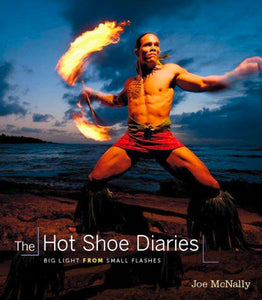I have to be honest here. I have never been prone to use an on-camera flash. I do use continuous lights for video and portrait work, but I have always tried to keep it simple. In the landscape, I am used to natural light and positioning subjects in my travel photography in available light so as to maximize the use of what I have. Flash seemed to me to be all wizardry and electronic craziness that I never seemed to be able to get a grasp on the few times I really needed it. Then I read this book.
The Hot Shoe Diaries: Big Light from Small Flashes by Joe McNally is an extensive series of situations that would be enhanced by flash photography. Joe McNally initially gives the reader some background on the equipment that he uses (Nikon camera gear followed by a variety of do-dads such as lighting stands, reflectors, soft boxes big and small, etc) and then launches into an almost exhaustive 1-3 page scenarios on everything from a cowboy smoking in a room to an executive in his office overlooking a bay with dusk light. While I usually have a hard time finishing such books, I found myself amused by Joe's style and intrigued by the relative simplicity and straightforwardness of his setups.
STYLE
Joe McNally seems to be that kind of guy who always makes the same jokes at the family reunion every five years and you tolerate him knowing that he will be gone in three hours. I thought that was how the book was going to roll after a few pages. The difference with this chararacter and Joe is that Joe gets progressively more amusing in the book. He's chosen a style to demystify the use of flash and in a very self-effacing, rambling, and even mildly crude way, comes off showing you how easy it can be. The jokes and jabs are never at you, but at himself and the equipment, making you realize that he can get as frustrated as you do at the blinking lights and the crazy situations he finds himself in while photographing.
Even though I currently shoot Canon, I feel fluent now in which flashes and commander units a Nikon shooter would use, and I believe that I can order up my Canon equipment (wires, new flashes, and off camera communication equipment) in a way that learning Spanish will help me learn Italian.
FORMAT
Joe takes the reader through scenarios, which correlates well with his title "Hot Shoe Diaries." It literally reads like diary entries with fairly random (but useful) situations. These are not contrived for the book itself, but appear to be a conglomeration of situations that have arisen for him during commercial, editorial, personal, and even workshop situations. The short two to three-page "entries" help the reader to see the situation, the problem presented, and then Joe's solution. There are even times when he admits that his solutions were not top-quality or that he even missed the shot. All of these follies help the reader understand Joe's sentiment that flash photography just "ain't mathematics." I am not one to enjoy the technical aspects of photography, but Joe actually made it interesting, again, by using a healthy dose of humor and very random slang phrases.
WHAT YOU'LL LEARN
Joe McNally's book The Hot Shoe Diaries: Big Light From Small Flashes focuses on the use of speedlights, mainly Nikon (but Canon and other users can get what he's talking about). You'll learn what a flash looks like from the point of view of the hotshot and then moved off-camera (this is heavily emphasized). Joe will show you repeatedly how to color balance your flash with gels, and incessantly uses the combination of lowering the exposure compensation of the camera exposure and raising the exposure compensation of the flash in order to get a properly lit subject. The simple things like using wide angle (24 mm) or long (105 mm) flash direction and dialing the flash up or down will be repeated in different situations and different lighting, which is a helpful way for the learning photographer to understand his techniques.
BOTTOM LINE
This book is a go, and I was pretty skeptical at first. I think it's worth the price in what photographers will get who are unfamiliar with flash photography (or learning it). Push through the equipment list as you will probably not buy everything he uses, and the rest is learning/entertainment. After reading it, you will probably want to buy some simple gels for your flash, an off-camera communication system (physical connector or Pocketwizard/Elinchrome solution), and a simple diffuser (Gary Fong or otherwise). You'll be amazed at what you might learn.
RELATED ARTICLES
Timeless Principles in Black and White Photography
Book Review: GOING PRO: How to Make the Leap from Aspiring to Professional Photographer
Book Review: Understanding Exposure


